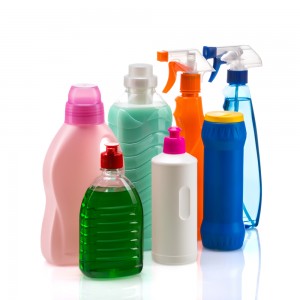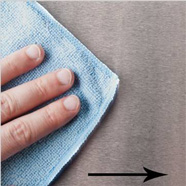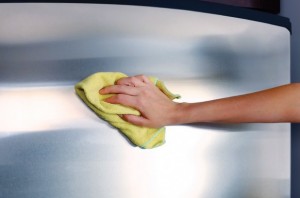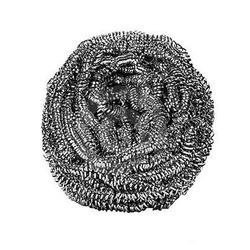Nowadays you can find stainless steel appliances in every modern kitchen. These shiny surfaces make your home more elegant and add one gleaming image to your kitchen space. Keeping that image, however, needs some effort from your side. Cleaning stainless steel surfaces may be a real pain in the neck so We would like to show you how not to clean them in order to keep the surface undamaged.
The most important thing to know is what not to do when cleaning stainless steel surfaces.
Stainless steel can be the most resistant material to rust and normal wear and tear. If you take proper care when cleaning stainless steel surfaces, it will shine as new for many years. Unfortunately, you cannot save your kitchen from any grime or stains, no matter what appliances you use. Have in mind, that stainless steel needs specific cleaning and if you are not sure you will handle it, call a professional company.
1. Do not use cleaning products, which are not suitable for stainless steel.
You should always read the labels when you choose cleaners. Many of them can scratch or damage your stainless steel surfaces. Never clean with:
- abrasive cleaners – they contain tiny particles of product that will harm these surfaces;
- bleach – it is a product, that every housekeeper uses very often, but not in this case, it will damage stainless steel surfaces, leaving some unpleasant stains;
- products, containing chloride – they harm the protective finish of shiny surfaces;
- oven cleaners – these products are very harsh because they are produced to clean really stubborn stains;
- dirty tap water – if your tap water is gritty or with a high content of calcium, it can leave white or brownish stains after rinsing and drying.
You can use special stainless steel cleaners. As a precaution, though, read the instructions before cleaning. It is better to test it first on a small space on the surface, that is rather hidden. Another option is to make a natural cleaner with white vinegar and water. For stains, apply some baking soda and wipe it gently. If you need to remove some fingerprints, it is safe to spray with glass cleaner.
2. Do not use brushes, that will scratch the stainless steel surfaces.
Scratching the surface will make it susceptible to staining. You should not buy:
Materials that are safe when cleaning stainless steel surfaces may be a synthetic scouring pad, soft sponge, or microfiber cloth. You can also use an old toothbrush for stains or some tiny spaces that need gently brushing.
3. Do not forget to polish and dry after cleaning.
If you want to have that shiny new look on your stainless steel surfaces, you need to polish them with special products. That is an important step in your efforts to make your kitchen gleaming. When you do that, you have to wipe with a soft cloth in the same direction as the “grain lines” on the steel surfaces. Begin from top to bottom and that is how you will not leave any marks or prints. You can polish these surfaces with silicone-based products or polishing pastes that are specially made for this use. You can also use some common oils that you have in your household such as olive oil, lemon oil, or baby oil. Finish with a paper towel to dry the surface. Be aware that polishing is made mainly on decorative stainless steel elements, which excludes materials where food is prepared.
special products. That is an important step in your efforts to make your kitchen gleaming. When you do that, you have to wipe with a soft cloth in the same direction as the “grain lines” on the steel surfaces. Begin from top to bottom and that is how you will not leave any marks or prints. You can polish these surfaces with silicone-based products or polishing pastes that are specially made for this use. You can also use some common oils that you have in your household such as olive oil, lemon oil, or baby oil. Finish with a paper towel to dry the surface. Be aware that polishing is made mainly on decorative stainless steel elements, which excludes materials where food is prepared.
Stainless steel is one of the hardest surfaces to clean because it requires very specific treatment. If you think that is better to call professionals, just do it. The result is sparkling and it is worth it!
We provide high-quality cleaning service at an affordable price. Our experienced team of professionals prides themselves in maintaining the highest standards.
When you move out from a rented property, there are a number of things which must be planned and organized. This includes the end of tenancy cleaning, which a large number of landlords are now insisting be done by a professional cleaning company. Our end of tenancy cleaning services are designed to help take the pressure off you and ensure that you are 100% satisfied with the outcome.



